Head of the Economic Office at the Central Bank of Iran has touted the government’s oversight and control of liquidity, saying the ideal growth for money supply in an economy like Iran would be approximately 17%.
“Considering the government’s efforts to subdue inflation, prop up growth and end the recession without stoking inflation, the optimal rate for money supply growth would be 16%-17%,” Abolfazl Akrami was quoted as saying by IRNA late Monday.
Akrami responded to critics who argued the money supply had expanded immoderately under the current administration, saying the government had intensified its oversight over informal money markets and had also upgraded its methods of ensuring data become available at shorter intervals.
Iran’s money stock grew 4.4% during the first quarter of the current Iranian year to 8.16 quadrillion rials ($247.47 billion at market exchange rate of 33,000 rials per dollar). The data disclosed by CBI in early August shows a 22.7% increase at an annualized rate in broad liquidity in June 2015, which is a rapid growth considering the government’s determination to rein in money supply increase.
A reason for this surge in money supply is because CBI took the liquidity held by several newly-licensed credit and financial institutions into account, he said, adding that the data were absent in the previous money supply reports.
According to Akrami, money supply growth for the next calendar year (beginning March 2016) is forecast to be around 38.8%. In the previous year (ended March 20, 2015) liquidity growth was 23.3%.
“Only in 2013 we added six banks and four credit institutions to our data list and this process is continuing. Accounting for these banks and credit institutions alone has added 800 trillion rials to the money stock data,” he noted.
“Part of the money supply growth in the Rouhani administration is the result of money intensifier and increased transparency in tracking money circulation. It has less to do with a rise in monetary base.”
Emphasizing that the central bank is not after increasing the money base, Akrami argued that by accounting for all the aforementioned factors, the money supply has even slumped during this period.
Earlier this month, Minister of Economy Ali Tayyebnia forecast a decline in money supply once Iran’s assets frozen abroad are released. The country will have access to over $100 billion in frozen funds once sanctions are llifted, but CBI officials say only $29 billion are now accessible, of which $23 billion belong to the central bank as international reserve and $6 billion, mainly the proceeds of oil sales, will go to the government.


